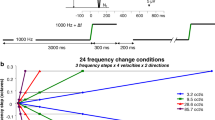Summary
Objective audiometry (evoked response audiometry) is a valuable adjunct to the subjective methods of hearing assessment with respect to the fitting of hearing aids in hard-of-hearing patients. It is especially helpful in children as the application of subjective method is often limited in such cases. Auditory function as assessed by evoked-response audiometry may be compared between adults and children. Earlier studies indicated that children below the age of 2 years show elevated thresholds.
Evoked response measurements were taken in two groups: one consisting of eleven normal-hearing adults and the other of fifteen normal-hearing children between the ages of 3 and 6 years. Responses to a 1 kHz signal were picked up from three different places (contra-lateral, ipsi-lateral, and vertex) in a synchronized manner. This method is considered sufficient for getting an approximate information with regard to the adaptive state of the auditory system. In all three channels, the response characteristic rose initially steeper in adults than in children. In adults, however, the characteristics tended to level off above SPL of 60 dB, at least for contra- and ipsi-lateral pick-ups, thus crossing those obtained in children. For the pick-up from the vertex, the adult characteristic continued its steper rise so that at corresponding points values were 38 above those measured in children.
In order to obtain further information, response characteristics were measured for frequencies of 0.5, 1, 2, and 4 kHz in the group of children. Up to an SPL of 50 dB, all curves had essentially the same positive slope. Above that level, the 4 kHz curve began leveling off. At an SPL of 90 dB, highest values of cortical responses were found for 0.5 kHz, and lowest for 4.0 kHz, both when calculated according to the method of Spreng (1967). The frequency dependence of the ERA response characteristic was statistically significant, especially for the contra-lateral pickup. The latency of N1 as a function of SPL may be used as a further diagnostic criterion. Its value ranges from 140 msec at 90 dB SPL to 250 msec at 10 SPL. In children, latencies are 50–80 msec longer than in adults.
Zusammenfassung
Die Reizstärke-Erregungskennlinien akustisch evozierter Potentiale für 1,0 kHz des adaptierten Systems zeigen Unterschiede im Kennlinien verlauf beim Vergleich von 15 normalhörenden 3–6 jährigen Kindern and 11 normal hörenden Erwachsenen. Am Vertex sind bei Erwachsenen die Amplituden signifikant höher und der Anstieg der Kennlinie steiler. Die Keunlinien normalhbrender Kinder werden mit zunehmender Frequenz (0,5–4,0 kHz) flacher, signifikant bei 60–90 dB SPL für die contra-ipsilaterale Ableitung und Ableitung am Vertex. Die Latenzen für N1 liegen bei den untersuchten Kindern zwischen 250 msec bei niedrigem und 140 msec bei hohem Schalldruck und sind damit gemessen an Erwachsenen um 40–80 msec länger. Am Beispiel eines hörgestörten 6jährigen Kindes wind der Wert eines Cerebro-Audiogrammes bei schwieriger hörprothetischer Versorgung dargelegt. Die subjektiven Hörprüfungen dieses Kindes ergaben eine symmetrische, typische U-förmige Kurve des Audiogrammes. Diese konnte mittels ERA-Audiogramm nicht bestätigt werden. Am linken Ohr werden sowohl eine giinstigere Hörschwelle als auch ein der Norm näher liegender Kennlinienanstieg gefunden. Ferner lag am linken Ohr auch das Latenzverhalten von N1 näher dem Normalen. Aus den Ergebnissen der ERA-Untersuchung wird verständlich, daß das Kind eine beidohrige Hörgeräteversorgung nicht tolerierte. Durch die Ergebnisse der ERA-Prüfung konnte das Kind dann auf dem linken Ohr mit gutem Erfolg hörprothetisch versorgt werden.
Similar content being viewed by others
Literatur
Beagley, H. A.: Persönl. Mitteilung an Stange (1971).
—, Burian, K., Davis, H., Gestring, G. F., Morgon, A., Spreng, M., Stange, G., Zöllner, F.: Round-Table-Conference, I. Int. ERA-Symposion, April 1970 in Freiburg i. Br. Arch. klin. exp. Ohr.-, Nas.- u. Kehlk.-Heilk. 198, 167–176 (1971).
—, Knight, J. J.: Changes in auditory evoked response with intensity. J. Laryng. 81, 861 (1967).
—, —: The auditory evoked cortical response as an index of hearing practical audiometry. J. Laryng. 81, 347 (1967).
Davis, H.: Arch. klin. exp. Ohr.-, Nas- u. Kehlk.-Heilk. 198, 172 (1971).
Holm, C.: Diskussionsbeitrag auf dem I. Int. ERA-Symposion, April 1970 in Freiburg i. Br. Arch. klin. exp. Ohr.-, Nas.- u. Kehlk.-Heilk. 198, 101 (1971).
—Stange, G.: Importance des lignes de stimulation excitation évoqués acoustiques pour la discrimination de la parole chez l'enfant. Journées Européennes des Centres D'Audiophonologie, Lyon, Déc. 1970. J. frang. Oto-rhino-laryng. (im Druck) (1972).
Keidel, W. D.: What do we know about the human cortical evoked potential after all? Vortrag I. Int. ERA-Symposion, April 1970 in Freiburg i. Br. Arch. klin. exp. Ohr.-, Nas.- u. Kehlk.-Heilk. 198, 9–37 (1971).
Morgon, A., Charachou, D., Gerin, P.: Electro-encephalographic audiometry for young children. Arch. klin. exp. Ohr.-, Nas.- u. Kehlk.-Heilk. 198, 144–150 (1971).
Spreng, M.: Über die Messung der Frequenzgruppe und der Integrationszeit des menschlichen Gehörs durch von Schall abhängige Hirnspannungen längs der Kopfhaut. Dissertation, T.H. Stuttgart 1967.
Stange, G.: Résultats Cliniques d'une Audiométrie objective chez le Nouveau — Né et le Jeune Enfant. Colloque International, Besangon, 9.–12. Déc. 1969, in La Surdité Du Premier Age, Hrsg. L. Lafon, Edit. Camponovo Besançon, pp. 240–251 (1971).
—: The relation between functional parameters of subjective and objective audiometry. Arch. klin. exp. Ohr.-, Nas.- u. Kehlk.-Heilk. 198, 85–101 (1971).
—, Holm, C.: L'utilisation clinique de l'audiométrie Electroencephalographique. J. franç. Oto-rhino-laryng. 19, 61–71 (1970).
—,: Gemittelte zentrale akustische Reizantworten — eine Erweiterung pädaudio-logischer Gesichtspunkte? HNO (Berl.) 18, 27–28 (1970).
Author information
Authors and Affiliations
Additional information
Mit finanzieller Unterstützung des “SFB 70” (Sonderforschungsbereich für Hirnforschung und Sinnesphysiologie der deutschen Forschungsgemeinschaft) und “Stiftung Volkswagenwerk”.
Zum Teil vorgetragen auf dem II. Int. ERA-Symposion vom 1.–4. September 1971 in Wien.
Rights and permissions
About this article
Cite this article
Benning, C.D., Karnahl, T. & Stange, G. ERA-Kennlinien und latenzen bei 15 normalhörenden Kleinkindern. Arch. klin. exp. Ohr.-, Nas.- u. Kehlk.Heilk. 201, 222–230 (1972). https://doi.org/10.1007/BF00398005
Received:
Issue Date:
DOI: https://doi.org/10.1007/BF00398005




